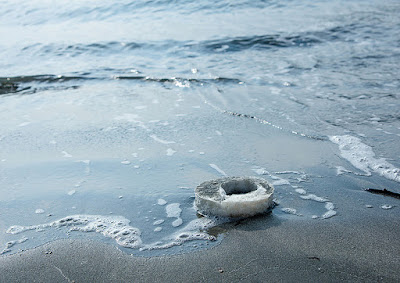Introduction
The Japanese studio AMAM work with agar, a seaweed-based material to develop new and more eco-friendly ways of packaging goods. Their current ongoing project is called Agar Plasticity: a Potential Usefulness of Agar for Packging and More. It has been named as the Grand Prix winner for this year's Lexus Design Award for emerging designers.
Agar is traditionally consumed as a food in Japan for making sweets. It is also been used in scientific and medical fields internationally. Agar can be extracted from red algae. Because of the porous, feathery structure and the very low density of black algae, it is potential to be explored as packaging material. Other biodegradable substances like mushrooms have also been explored as a plastic alternative. However, agar is propelling into exciting, uncharted territory, as "no one has ever explored the possibility of agar to replace plastic packaging and there are lots of things unknown." (AMAM, 2016)
Material Experimentation
AMAM has done material experiments of pure agar powder and combination of agar powder with others.Through countless experiments, they managed to produce transparent films, loose-fill cushioning using only powdered agar. Combining agar powder with extracted red algae fiber was able to produce material with various hardnesses and thickness, which could be used as wrapping for flowers, or as cushioned for wine bottles, or molded to make boxes. The composite from shell ash and agar powder becomes could be molded into complicated shapes, even like wall tiles. Therefore,
They has produced a selection of products and packaging which are possible to replace plastic products like shopping bags, cable tie, toothbrush, cutlery, ballpoint pen, etc.
 |
| Material Experiment |
 |
| A collection of prototypes made using agar as a prime ingredient |
Disposing
Agar could also be disposed of in an environmentally friendly way. As AMAM written on their website, "When disposing of these, all of them can be utilised as a material improving water retention of soil or as fertiliser with well water-retention, because agar absorbs and holds water very well, or should they end up in the ocean or landfill, they would not be harmful to the environment, to other lives. The agar simply biodegrades." (AMAM, 2016)
Analysis
"In 2012, two hundred and eighty-eight million tons of plastics were produced worldwide, and more than 36% of materials used for packaging were plastics which is as synthetic material that is not biodegradable."(AMAM, 2016) This severe environmental situation is the motivation of the project. "This is a bold and ambitious experiment, which aims to address one of the biggest pollution problems of our time. The designers have made tremendous progress during the course of the award cycle, particularly in devising a wide range of possible practical applications for the material. Their success in doing so gives us confidence in their ability to tackle the many challenges and complexities they will face in continuing the development of the project.” said Alice Rawsthorn (2016), Lexus Design Award 2016 judge.
The only worry I had about the agar packaging is the water absorptivity of the material. Waterproof is still an advantage of plastic as a packaging material, as it could against weather condition and is more protective. I am hoping further research and development of this project could overcome this weakness.
The benefit of replacing plastic with agar is inevitable, as agar could be extracted from waste algae and is biodegradable. Besides environmental aspect, I found it is also more organic and subtle esthetically. I would love to receive a product packaged by agar than plastic.
Reference
AMAM. (2016). AMAM. [online] Available at: http://www.a-ma-m.com [Accessed 17 Nov. 2016].
Dawood, S. (2016). Lexus Design Award 2016 - from seaweed packaging to a toy for autism - Design Week. [online] Design Week. Available at: https://www.designweek.co.uk/issues/11-17-april-2016/lexus-design-award-2016-from-seaweed-packaging-to-a-toy-for-autism/ [Accessed 17 Nov. 2016].
Rawsthorn, A. (2016). AMAM wins Lexus Design Award 2016 with Agar plasticity - Lexus. [online] Lexus. Available at: http://blog.lexus.co.uk/amam-wins-lexus-design-award-2016/ [Accessed 17 Nov. 2016].






